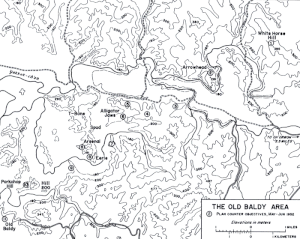Battle of Old Baldy
| Battle of Old Baldy | |||||||
|---|---|---|---|---|---|---|---|
| Part of the Korean War | |||||||
 Map of the Old Baldy area |
|||||||
|
|||||||
| Belligerents | |||||||
|
|
|||||||
| Strength | |||||||
| 38,000 | 20,000 | ||||||
| Casualties and losses | |||||||
| 357 killed and wounded | 1,100 killed and wounded | ||||||
The Battle of Old Baldy refers to a series of five engagements for Hill 266 in west-central Korea. They occurred over a period of 10 months in 1952–1953, though there was also vicious fighting both before and after these engagements.
As May turned to June, Major General David L. Ruffner of the 45th Division holding the right flank of the I Corps' line, was frustrated by the view that enemy observers had of his division’s positions. Opposing the 45th Division from east to west were elements of the Chinese 338th and 339th Regiments (113th Division, 38th Army), the 350th and 349th Regiments (117th Division, 39th Army), and the 344th Regiment (115th Division, 39th Army). The other infantry components of the 113th, 115th, and 117th Divisions were in reserve, as was the 116th Division, 39th Army. The Chinese had over ten battalions of artillery positioned along the front in direct or general support roles. Maj. Gen. Ruffner laid plans for Operation Counter, a two-phase operation to capture and hold 12 outposts a few thousand yards in front of the main line. One of the most prominent hills came to be called "Old Baldy", which earned its nickname after artillery and mortar fire destroyed the trees on its crest. But as the highest point on a prominent east-west ridge, Old Baldy held strategic importance because it dominated terrain in three directions.
...
Wikipedia
